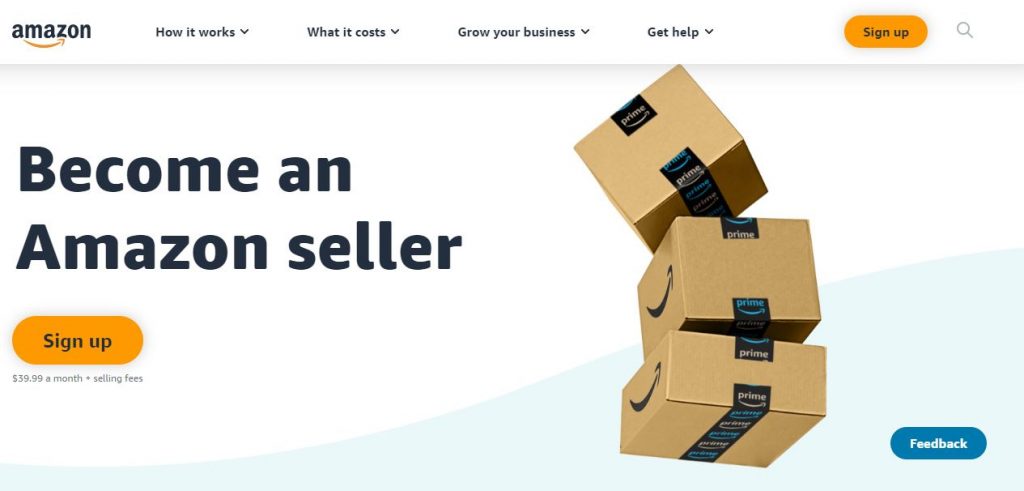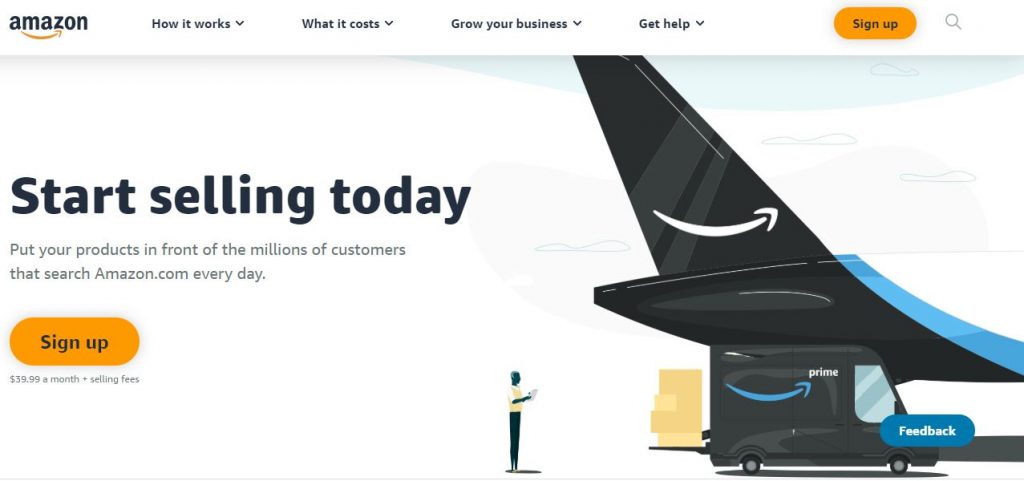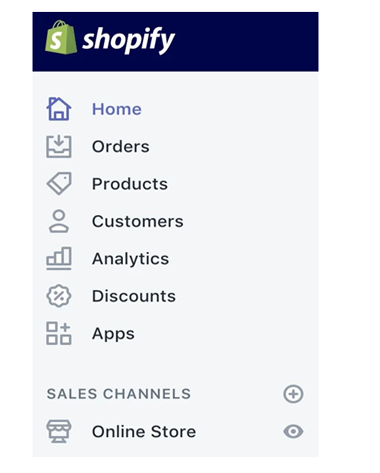How to Sell on Amazon Using Shopify: A Comprehensive Guide
Today, many people believe that a huge capital is needed for business because of the obligations attached to it. They calculate the financial commission that goes with hiring a salesperson as well as acquiring the cost of maintaining a shop or showroom. These can be avoided by selling your product on your own online stores rather than a physical location.
Shopify offers owners of businesses, entrepreneurs, and companies this opportunity and saves a lot of fortune with little or no difficulty.
All you will need is a reliable internet connection to successfully run and manage your Shopify online store. Shopify is a digital marketing platform that is stored and managed on remote servers, with the internet as its host. As was earlier mentioned, instead of sitting at a shop or showroom location at a particular strategic point, you can start, own, build, and manage your business effectively online, irrespective of where you are in the world.
One major hindrance many face while using this online platform is generating enough traffic on their website to expose their business. The integration of Shopify and Amazon solves this problem and bridges the gap between customers and products. A simple technique is by making Amazon, on your online store, a “sales channel.” This singular act of integration can magnetize or attract countless potential customers who stream to Amazon for their various buying needs.
In this article, we will be considering one step after the other on how to sell on Amazon using Shopify and market your products and services through your Shopify store on Amazon.
Understanding the Basics
Before diving into the integration of Shopify and Amazon, it’s essential to grasp how the two platforms work together and the potential limitations you may encounter. While the integration offers significant benefits, such as increased exposure and streamlined operations, understanding its constraints will help you manage expectations and make informed decisions for your business.

Key Limitations of Shopify-Amazon Integration
- Category Restriction
Currently, products listed through the Shopify-Amazon integration are restricted to the Clothing and Accessories category. This means sellers offering products in other categories, such as electronics, home goods, or food items, cannot take advantage of this integration at this time. While this limitation may seem restrictive, the Clothing and Accessories category is vast and includes a wide range of items such as apparel, footwear, bags, and jewelry.
However, Shopify and Amazon are continuously evolving their features, and it’s possible that this restriction may be lifted or expanded in future updates. For now, sellers who operate outside this category will need to explore alternative methods to list their products directly on Amazon.
- Currency Limitation
One significant drawback of the integration is the inability to display prices in multiple currencies. Currently, prices are shown exclusively in US dollars (USD).
This limitation can pose a challenge for sellers targeting international customers, as it requires buyers to manually calculate the cost of products in their local currency. To mitigate this, sellers can clearly communicate pricing details in product descriptions or include conversion guidelines to reduce confusion for customers shopping from outside the United States.
- No Access to Fulfillment by Amazon (FBA)
The Shopify-Amazon integration does not provide access to Fulfillment by Amazon (FBA) services. FBA is one of Amazon’s flagship programs, designed to simplify the logistics of online selling. With FBA, sellers can ship their inventory to Amazon’s fulfillment centers, where Amazon handles the storage, packaging, and shipping of products.
The absence of FBA in the Shopify integration means that sellers must manage their inventory and shipping logistics independently. While Shopify’s built-in inventory management and shipping features are robust, they don’t offer the same level of convenience and scalability as FBA. Sellers using the Shopify-Amazon integration will need to ensure that they have reliable shipping processes in place to deliver products on time and maintain customer satisfaction.
Additional Considerations
- Marketplace Fees: While there is no charge to list products through the integration, sellers should be aware of Amazon’s referral fees, which vary by product category and are deducted from each sale.
- Inventory Synchronization: While the integration allows for automatic synchronization of inventory, ensuring accurate stock levels across platforms is essential to avoid overselling or stockouts.
- Customer Reviews: Products listed on Amazon are subject to Amazon’s review system, which means that customer feedback can influence your brand’s reputation and visibility on the platform.
Understanding these limitations upfront will help you better prepare for the integration process and develop strategies to work within these constraints. While there are some drawbacks, the benefits of accessing Amazon’s vast customer base and leveraging Shopify’s easy-to-use platform make the integration a valuable opportunity for many sellers.
Set Up You Amazon Seller Account
Integrating Shopify with Amazon requires an Amazon Seller Account. This account is the foundation for listing your products on Amazon and managing your sales. Amazon offers two types of seller accounts, each tailored to different business needs. Choosing the right one will depend on the scale and frequency of your sales.
Types of Amazon Seller Accounts
- Individual Seller Account
- Best for individuals or small-scale sellers who plan to sell a limited number of products occasionally.
- No monthly subscription fee, but a $0.99 fee is charged per item sold.
- Suitable for hobbyists, students, or anyone testing the waters of online selling.
- Professional Seller Account
- Designed for serious business owners with a consistent and steady supply of products.
- Costs $39.99 per month, regardless of the number of products sold.
- Includes advanced selling tools, bulk listing capabilities, and access to additional categories.
- Ideal for businesses planning to scale and generate significant revenue through Amazon.
Required Information for Registration
To create your Amazon Seller Account, you’ll need the following details:
- Registered Business Name and Address
- If you operate a business, ensure it is registered with the appropriate authorities in your country.
- Provide a valid business address for correspondence and verification purposes.
- Unique Contact Information
- Use a valid and accessible email address dedicated to your business.
- Amazon will use this email to send important notifications, updates, and account-related information.
- Credit Card with International Billing Address
- A valid credit card is essential for account creation.
- The card must be capable of international transactions, as Amazon may charge subscription fees or other costs in USD.
- Tax Identification Number (TIN)
- Amazon requires your TIN to validate tax compliance.
- Ensure your tax records are up-to-date, as Amazon will verify this information before approving your account.
Steps to Create Your Amazon Seller Account
Follow these steps to set up your account:
1. Visit Amazon’s Seller Page
-
- Open your browser and go to services.amazon.com or sellercentral.amazon.com.

2. Start the Registration Process
-
- On the homepage, click the Start Selling or Sign Up button to begin.

3. Choose Your Account Type
-
- Select either the Individual or Professional plan based on your selling needs.
4. Fill Out the Registration Form
-
- Provide all the required information, including your business name, email address, and credit card details.
5. Verify Your Identity
-
- Amazon may ask for additional verification, such as submitting identification documents or tax-related forms.
6. Agree to Amazon’s Terms and Conditions
-
- Read and accept Amazon’s seller agreement to finalize your account creation.
7. Complete Your Seller Profile
-
- Once registered, complete your profile by adding essential details like business logos, payment information, and shipping preferences.
Pro Tips for Setting Up Your Account
- Prepare Your Documents in Advance: Having all the required information and documentation ready will streamline the registration process and prevent delays.
- Choose the Right Account Type: If you’re uncertain about scaling your business immediately, you can start with an Individual Seller account and upgrade to a Professional Seller account later.
- Set Up Notifications: Ensure your contact information is accurate to receive timely updates from Amazon.
By following these steps and ensuring all necessary details are in place, you’ll be ready to integrate your Shopify store with Amazon and begin reaching a broader audience.
Add Amazon as a Sales Channel in Shopify
Adding Amazon as a sales channel in your Shopify store is a crucial step in streamlining your e-commerce operations. This integration enables you to manage your products and sales from a single dashboard while leveraging Amazon’s massive customer base. Here’s how you can set it up step-by-step:
Steps to Add Amazon as a Sales Channel
- Log in to Your Shopify Store
- Access your Shopify admin panel using your credentials.
- Navigate to the Sales Channels Section
- On the left-hand side of the dashboard, locate the Sales Channels section.
- Click on the + icon next to it to add a new channel.
- Select Amazon by Shopify
- In the list of available sales channels, look for Amazon by Shopify.
- Click on it and select Add Channel to initiate the integration.
- Connect Your Amazon Seller Account
- Follow the on-screen prompts to link your Amazon Seller Account with Shopify.
- You’ll need to grant permissions for Shopify to access and manage your Amazon listings and orders.
- Authorize the Integration
- Once connected, Shopify will request authorization to access your Amazon Seller Account.
- Approve this to finalize the setup.
Benefits of Integration
By integrating Amazon as a sales channel in Shopify, you unlock several advantages that simplify your selling process:
- Inventory Synchronization
- The integration ensures that product quantities and details are automatically updated on both platforms.
- If a product sells on Amazon, Shopify’s inventory adjusts in real time, preventing overselling.
- Centralized Management
- Manage all your products, pricing, and customer orders directly from your Shopify dashboard.
- Eliminate the need to switch between platforms for updates or monitoring.
- Expanded Customer Reach
- Leverage Amazon’s massive audience to gain more visibility for your products.
- Customers browsing Amazon can now discover and purchase items from your Shopify store.
- Improved Efficiency
- Automate manual tasks like updating product descriptions, prices, and stock levels.
- Focus on other aspects of your business, such as marketing and customer service.
Pro Tips for a Smooth Integration
- Prepare Your Product Listings: Ensure that your product descriptions, images, and details comply with Amazon’s requirements to avoid listing errors.
- Use Amazon-Specific Titles: Tailor your product titles for Amazon to enhance visibility in search results.
- Monitor Synchronization: Regularly check that inventory updates are functioning correctly to avoid stock discrepancies.
- Optimize Pricing: Use dynamic pricing strategies to remain competitive on Amazon while maintaining profitability.
What’s Next After Integration?
Once Amazon is added as a sales channel, take the following steps to maximize its potential:

- Set Up Product Listings: Assign your Shopify products to existing Amazon listings or create new ones directly from Shopify.
- Adjust Inventory Settings: Configure inventory preferences to manage stock levels automatically.
- Track Amazon Orders in Shopify: Monitor and fulfill orders placed on Amazon through your Shopify dashboard.
With this integration, your Shopify store becomes a powerful hub for managing sales across both platforms, simplifying operations and boosting revenue.
3. Select Inventory Setting That Fits Your Business
Rather than setting up your wares manually, you can automatically set up your wares on Amazon by using Shopify store inventory. You are able to watch over your product through the inventory. In case your stock is no more available, the inventory will quickly let you see the need for restocking it. That is the products’ quantity are effectively synchronized. It is a very easy and affordable process.
4. Start Your Sales
On point! You can now start selling on Amazon through your Shopify store because all your products added are now been synchronized on both platforms. Those who are visitors and customers on Amazon can now find your product and thereby patronize you. You can find the buyers of these products under the order list tagged Amazon of your Shopify store. Yes, start selling. You are set.
How to Optimize Your Shopify-Amazon Integration
If you want to make the most out of selling on Amazon using Shopify, optimizing your integration is key. This involves leveraging tools and strategies that improve efficiency, enhance visibility, and ultimately drive more sales. Here are some ways to optimize your setup:
1. Enhance Product Listings
Your product listings are the first point of contact for potential customers. Ensure your titles, descriptions, and images are compelling and informative.
- Use high-quality images with multiple angles.
- Include targeted keywords in your product title and description to rank higher in Amazon searches.
- Highlight unique selling points such as features, benefits, and promotions.
2. Optimize Pricing Strategies
Competitively pricing your products is essential to attract buyers.
- Use Amazon’s automated pricing tools to match or beat competitors.
- Factor in shipping and Amazon’s referral fees to ensure profitability.
- Offer discounts or bundles to incentivize purchases.
3. Leverage Amazon Advertising
Boost your product visibility by running targeted Amazon ads.
- Use Sponsored Products Ads to display your items in relevant search results.
- Analyze ad performance metrics like click-through rates (CTR) and conversion rates to refine your campaigns.
4. Streamline Inventory Management
Ensure your inventory is synced between Shopify and Amazon to prevent overselling or running out of stock.
- Use Shopify’s built-in inventory tracking tools to monitor stock levels.
- Set low-stock alerts to replenish inventory before running out.
5. Utilize Customer Reviews
Positive reviews help build trust and boost your product’s visibility on Amazon.
- Encourage satisfied customers to leave reviews.
- Address negative feedback promptly to show good customer service.
6. Analyze Performance Metrics
Track the performance of your Shopify-Amazon integration to identify areas for improvement.
- Use Shopify’s analytics tools to track sales and customer behavior.
- Review Amazon’s seller dashboard for insights into traffic, conversion rates, and product performance.
7. Expand Your Product Range
Start by focusing on a niche category like Clothing and Accessories, but explore opportunities to add more products as Amazon expands its integration capabilities.
By following these strategies, you can not only streamline your operations but also increase your chances of success when selling on Amazon using Shopify.
Including these optimization techniques in your workflow ensures you get the most out of your Shopify-Amazon integration. With careful planning and strategic execution, you can leverage the strengths of both platforms to achieve your business goals and thrive in the competitive e-commerce space.
Benefits of Selling on Amazon Using Shopify
When considering how to sell on Amazon using Shopify, it’s important to understand the unique advantages that come with this powerful integration. Both Shopify and Amazon bring distinct features to the table, and when combined, they offer a wealth of opportunities for businesses to grow and thrive in the online marketplace.
1. Access to Amazon’s Massive Customer Base
Amazon’s global reach is unmatched, with millions of active buyers browsing the platform every day. By connecting your Shopify store to Amazon, you open your business up to this vast audience without the need for extensive marketing efforts.
- Global reach: Gain access to Amazon’s international marketplaces, allowing you to sell in various regions and expand your customer base.
- Higher visibility: With Amazon’s dominance in e-commerce, your products can be discovered by customers who may not have found your Shopify store otherwise.
2. Streamlined Sales Process
How to sell on Amazon using Shopify not only allows you to tap into a broader customer base but also simplifies the selling process. Shopify’s user-friendly platform makes it easy to manage your store, while Amazon’s trusted reputation helps convert visitors into buyers.
- Centralized inventory management: Shopify automatically syncs your inventory with Amazon, ensuring that your stock levels are updated in real-time across both platforms.
- Order management: Manage orders, track shipments, and handle customer service seamlessly from one central dashboard.
3. Cost-Effective Business Model
Selling on Amazon through Shopify allows you to reduce many of the overhead costs associated with running a traditional business.
- No physical store expenses: Without the need for rent, utilities, and sales staff, you save significantly on operating costs.
- Reduced shipping costs: By utilizing Amazon’s fulfillment network (when available), you can reduce the burden of shipping and handling.
4. Increased Trust and Credibility
Amazon’s well-established reputation as a trusted marketplace can help boost your brand’s credibility.
- Customer trust: Buyers are more likely to purchase from a familiar, reliable platform like Amazon than from an unknown store.
- Secure transactions: Amazon’s secure payment system ensures peace of mind for both sellers and customers.
5. Access to Advanced Marketing Tools
By selling on Amazon through Shopify, you gain access to Amazon’s sophisticated advertising and marketing tools.
- Amazon ads: You can run targeted ads to increase product visibility and drive more traffic to your listings.
- Promotions: Utilize Amazon’s promotional tools, such as lightning deals and discounts, to attract buyers and increase sales volume.
6. Scalability
Whether you’re just starting or looking to expand, selling on Amazon using Shopify provides the scalability your business needs to grow.
- Easily add products: As your product catalog grows, you can add new items to your Amazon store without complicated processes.
- Adapt to demand: Whether you’re selling a few products or thousands, the integration allows you to manage your store effectively as your business evolves.
By exploring the benefits of how to sell on Amazon using Shopify, it’s clear that this integration provides a highly efficient and effective way to grow your business. It allows you to reach a broader audience, streamline operations, and reduce costs, all while leveraging the strengths of both platforms. Whether you’re a small entrepreneur or an established business, the Shopify-Amazon integration is an excellent strategy to expand your online presence and achieve long-term success.
Common Challenges When Selling on Amazon Using Shopify
While how to sell on Amazon using Shopify offers many benefits, it’s essential to be aware of the challenges that may arise when integrating the two platforms. Understanding these obstacles will help you better prepare for the complexities and find ways to overcome them.
1. Limited Product Categories
One of the primary challenges when using Shopify and Amazon together is the current limitation on product categories.
- Restricted to Clothing and Accessories: Currently, the integration allows you to only sell products in the Clothing and Accessories category. This restriction means that if your product falls outside of this category, you may need to explore alternative ways of selling on Amazon or wait for future updates that expand the integration.
- Future Updates: As both Shopify and Amazon continue to improve their integrations, there may be future updates that allow for more categories to be included. However, for now, you are limited to specific categories.
2. Currency Constraints
When integrating Shopify with Amazon, it’s important to remember that you can only list your prices in US dollars.
- Currency Limitations: This can be an issue if your business operates in other regions and you prefer to list your products in local currencies. Unfortunately, until this limitation is addressed, you must set all prices in USD, which can be a barrier for international sellers.
- Potential Currency Impact: Currency fluctuations can also affect your pricing strategy. If the value of the US dollar changes significantly, it could impact your product margins and pricing competitiveness on Amazon.
3. Lack of Fulfillment by Amazon (FBA)
One of the standout features of Amazon is its Fulfillment by Amazon (FBA) service, which handles storage, packing, and shipping of products. However, how to sell on Amazon using Shopify comes with the disadvantage of not having access to FBA through the integration.
- Manual Fulfillment: Since FBA isn’t available in the Shopify-Amazon integration, you are responsible for fulfilling orders manually. This may require additional time and resources, especially as your business grows.
- Shipping and Handling: You’ll need to either fulfill orders from your own warehouse or use third-party logistics services to handle shipping. This can become complicated and costly if your order volume increases.
4. Amazon Seller Fees
Though you can list products for free on Amazon, it’s essential to be aware of the fees that come with using the platform.
- Monthly Subscription Fees: Professional sellers need to pay a monthly subscription fee of $39.99, which may not be cost-effective for those just starting out.
- Selling Fees: In addition to the monthly fee, Amazon takes a percentage of each sale. These fees vary depending on the product category and can reduce your profit margins, so it’s important to account for these costs in your pricing strategy.
5. Inventory Management Challenges
Managing inventory can be tricky when syncing products between Shopify and Amazon.
- Inventory Synchronization: While Shopify automatically updates your inventory across both platforms, errors can occur if there are discrepancies in stock levels or if products are out of stock.
- Stock Management Complexity: You’ll need to ensure that your inventory is well-managed to avoid overstocking or understocking, especially if your products sell quickly. Inaccurate inventory counts can lead to backorders or lost sales, affecting your reputation.
6. Marketplace Competition
Selling on Amazon means competing with a vast number of sellers in your product category.
- Increased Competition: Even though Amazon provides an excellent opportunity to sell, it also means you’ll face stiff competition, especially from larger brands and well-established sellers. To stand out, you’ll need to focus on providing exceptional customer service, competitive pricing, and high-quality product listings.
- Price Wars: Due to Amazon’s competitive nature, you may find yourself engaged in price wars with other sellers. Keeping your prices competitive while maintaining healthy margins can be a delicate balancing act.
By understanding these common challenges, you can better prepare to manage and mitigate potential obstacles when learning how to sell on Amazon using Shopify. While these challenges may seem daunting, with proper planning and strategy, they can be overcome. It’s important to stay flexible and adapt as you grow your business, ensuring that you leverage the strengths of both Shopify and Amazon to maximize your success.
Conclusion: How to Sell on Amazon Using Shopify
Selling on Amazon using Shopify represents a transformative opportunity for businesses to grow, streamline operations, and expand their reach in today’s competitive e-commerce landscape. By integrating these two powerful platforms, you gain access to Amazon’s vast customer base while leveraging Shopify’s intuitive tools to manage your store effectively. This combination not only simplifies your sales process but also enhances your ability to scale quickly and efficiently.
Despite some limitations, such as category and currency restrictions, the benefits of integrating Shopify with Amazon far outweigh these challenges. You save on operational costs, gain global visibility, and provide customers with a seamless shopping experience, all of which contribute to your business’s long-term success. The ability to synchronize inventory across platforms ensures your store runs efficiently, preventing overselling and enhancing customer satisfaction.
For small entrepreneurs, this integration offers a cost-effective way to enter the e-commerce space and build a strong foundation for growth. For established businesses, it provides a means to amplify their brand presence and tap into new markets. The dual-platform approach allows you to focus on what matters most—delivering value to your customers—while the platforms handle much of the technical and logistical heavy lifting.
In a world where online shopping continues to dominate, taking advantage of Shopify and Amazon’s combined capabilities is a strategic move. Whether you aim to reach new customers, enhance profitability, or create a scalable e-commerce operation, this integration equips you with the tools to thrive. By embracing the synergy between Shopify and Amazon, you position your business to succeed in the ever-evolving world of e-commerce, ensuring sustainable growth and a competitive edge in the market.
Additional Resources:
- ConveyThis Integrations to explore compatibility with Shopify.
- How to Translate Shopify Checkout Page for more guidance.
- Help Guide for Translation Your Shopify Email Notifications for step-by-step support.
Translation, far more than just knowing languages, is a complex process.
By following our tips and using ConveyThis , your translated pages will resonate with your audience, feeling native to the target language.
While it demands effort, the result is rewarding. If you’re translating a website, ConveyThis can save you hours with automated machine translation.
Try ConveyThis free for 7 days!



